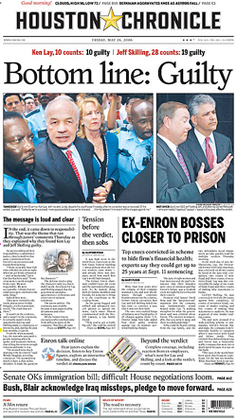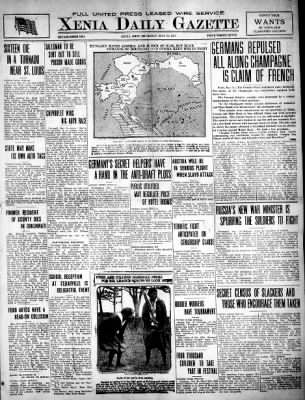
The Watergate scandal was a major political scandal in the United States involving the administration of President Richard Nixon from 1972 to 1974 that led to Nixon's resignation. The scandal stemmed from the Nixon administration's attempts to cover up its involvement in the June 17, 1972, break-in of the Democratic National Committee headquarters in Washington, D.C., at the Watergate Office Building.

The Washington Post, also known as the Post and, informally, WaPo, is an American daily newspaper. The Post is a global news outlet: It is published in Washington, D.C., operates international breaking news hubs in London, England, and Seoul, South Korea, and is the most widely circulated newspaper in the Washington metropolitan area.

The Houston Chronicle is the largest daily newspaper in Houston, Texas, United States. As of April 2016, it is the third-largest newspaper by Sunday circulation in the United States, behind only The New York Times and the Los Angeles Times. With its 1995 buy-out of long-time rival the Houston Post, the Chronicle became Houston's newspaper of record.

The Saturday Night Massacre was a series of events that took place in the United States on the evening of Saturday, October 20, 1973, during the Watergate scandal. US President Richard Nixon ordered Attorney General Elliot Richardson to fire Special Prosecutor Archibald Cox; Richardson refused and resigned effective immediately. Nixon then ordered Deputy Attorney General William Ruckelshaus to fire Cox; Ruckelshaus refused, and also resigned. Nixon then ordered the third-most-senior official at the Justice Department, Solicitor General Robert Bork, to fire Cox. Bork carried out the dismissal as Nixon asked. Bork stated that he intended to resign afterward, but was persuaded by Richardson and Ruckelshaus to stay on for the good of the Justice Department.
The Washington Star, previously known as the Washington Star-News and the Washington Evening Star, was a daily afternoon newspaper published in Washington, D.C., between 1852 and 1981. The Sunday edition was known as the Sunday Star. The paper was renamed several times before becoming Washington Star by the late 1970s.

The Star-Ledger is the largest circulation newspaper in New Jersey. It is based in Newark, New Jersey.
William C. Gaines was an American journalist and professor of journalism. Gaines was a Pulitzer Prize-winning investigative reporter for the Chicago Tribune. He retired from the paper in 2001 and taught in the Department of Journalism at the University of Illinois at Urbana-Champaign until his retirement and designation as an emeritus faculty member in 2007. He died on July 20, 2016, at the age of 82.
The Napa Valley Register is a daily newspaper located in Napa, California.
Leonard "Len" Downie Jr. is an American journalist who was executive editor of The Washington Post from 1991 to 2008. He worked in the Post newsroom for 44 years. His roles at the newspaper included executive editor, managing editor, national editor, London correspondent, assistant managing editor for metropolitan news, deputy metropolitan editor, and investigative and local reporter. Downie became executive editor upon the retirement of Ben Bradlee. During Downie's tenure as executive editor, the Washington Post won 25 Pulitzer Prizes, more than any other newspaper had won during the term of a single executive editor. Downie currently serves as vice president at large at the Washington Post, as Weil Family Professor of Journalism at the Walter Cronkite School of Journalism and Mass Communication at Arizona State University, and as a member of several advisory boards associated with journalism and public affairs.

The National Intelligencer and Washington Advertiser was a newspaper published in Washington, D.C., from October 30, 1800 until 1870. It was the first newspaper published in the District, which was founded in 1790. It was originally a Tri-weekly publication. It covered early debates of the United States Congress. The paper had a strong bias to Republicans and Thomas Jefferson.

Clifford Kennedy Berryman was a Pulitzer Prize–winning cartoonist with The Washington Star newspaper from 1907 to 1949. He was previously a cartoonist for The Washington Post from 1891 to 1907.

Scott Higham is an American investigative journalist and author who documented the corporate and political forces that fueled the opioid epidemic, in addition to conducting other major investigations. He is a five-time Pulitzer Prize finalist and won the Pulitzer twice with his colleagues at The Washington Post. He is a member of The Post’s investigative unit and the co-author of two books.

The Xenia Daily Gazette is a Pulitzer Prize-winning American daily newspaper published twice per week in Xenia, Ohio and its surrounding area. It is owned by AIM Media based in McAllen, Texas.

The Washington Bee was a Washington, D.C.-based American weekly newspaper founded in 1882 and primarily read by African Americans. Throughout almost all of its forty-year history, it was edited by African American lawyer-journalist William Calvin Chase. The newspaper was aligned with the Republican Party. It was published, with gaps in 1893 and 1895, until 1922, shortly after editor Chase's death.

National Baptist Memorial Church is a Baptist church in Washington, D.C. It is located at the intersection of 16th Street NW and Columbia Road, where the Mt. Pleasant, Columbia Heights and Adams Morgan neighborhoods meet. The crossroads is notable for the triple steeples of National Baptist Memorial Church, All Souls Unitarian Church and the Unification Church's cathedral.
More than 405 newspapers were founded in Washington, D.C., during the 18th and 19th centuries. They included daily, weekly, and monthly newspapers, mostly published in English, with a few in German and one in French. Many reported on news of national government affairs, since Washington, D.C., is the capital seat of the United States of America. Thomas Jefferson helped establish some of the early newspapers. During the American Civil War, some newspapers were founded and published in military camps and hospitals within Washington, D.C., including Brookland, Tenleytown, Carver General Hospital, Finley General Hospital, Armory Square Hospital, and Kalorama. Most of these newspapers ceased publication before 1900, but a few survived to the 20th century, including the Evening Star, and at least one to the 21st century: The Washington Post.










